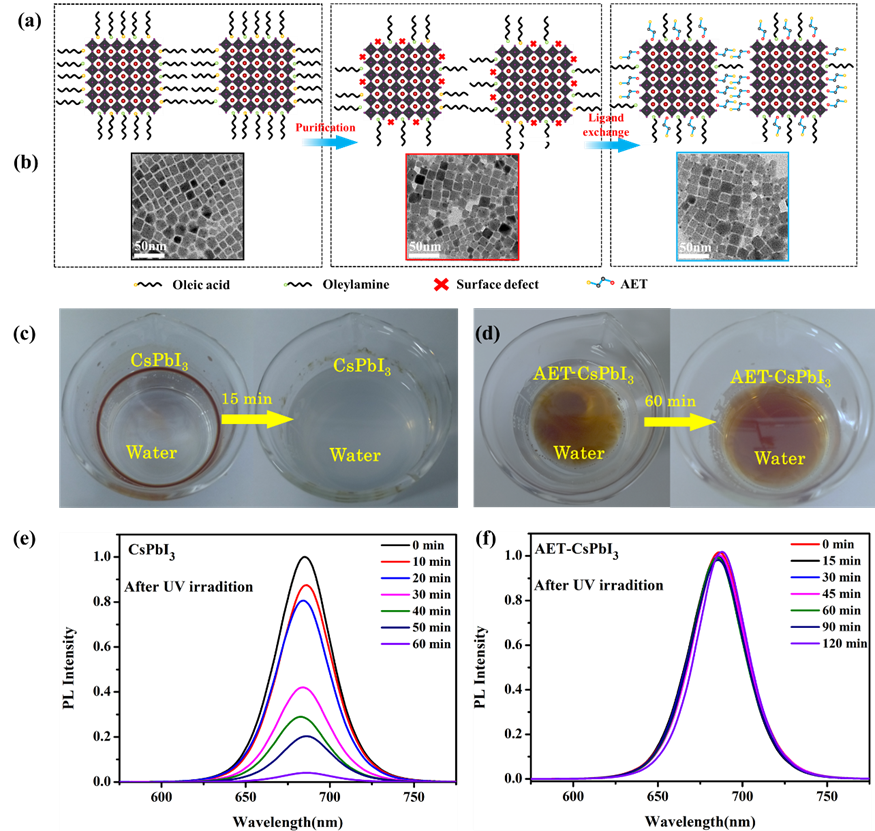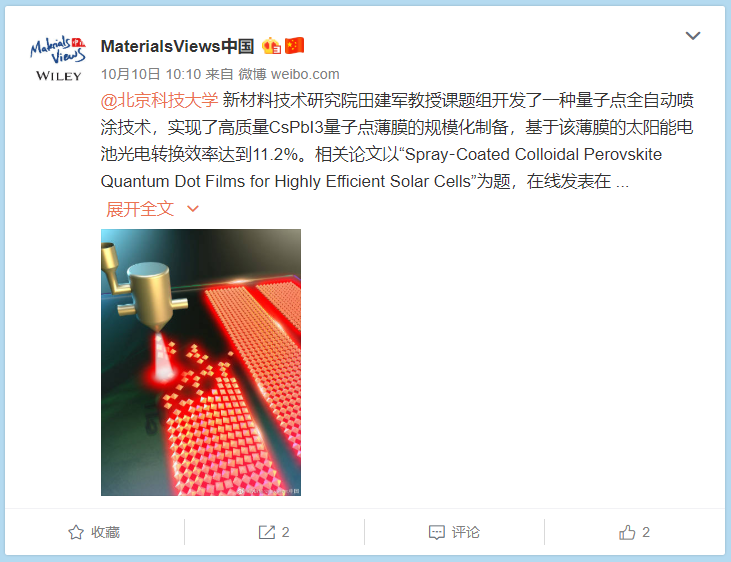Events
New progress on cesium lead halide quantum dots achieved by Tian’s research group of Institute for Advanced and Technology
Prof. Jianjun Tian’s group achieved two remarkable works of CsPbI3 quantum dots that were published in Advanced Functional Materials (IF=15.621), one of which was highlighted by the Materials Views of Wiley publishing group.
Colloidal all-inorganic halide perovskite (CsPbX3, X = Cl, Br, I) quantum dots (QDs) are emerging as high-performance materials for photovoltaic, photodetectors, and light emitting devices due to a number of useful characteristics, such as an easy tunability of the bandgap, long carrier lifetime, high charge carrier mobility, large extinction coefficient, and the possibility of a low-cost solution-based processing. In particular, the cubic structural CsPbI3 (black phase) CsPbI3 QDs with a bulk bandgap of 1.73 eV are attractive materials for optoelectronic devices. However, the small cesium ion (1.67 Å) is hard to support the cubic lattice, CsPbI3 can easily lose its structural integrity under humidity or under UV illumination, leading to decomposition
or unwanted phase transformation from cubic to orthorhombic phase (yellow phase). Due to the high surface energy of quantum dots and existence of organic ligands, to chemical synthesis quantum dots is one of the effective ways to stabilize CsPbI3 black phase. Even though, the problems such as poor stability, low carrier transfer property and difficulty in film formation are still faced.

Figure 1 Schematic illustration of the changes of ligand density, interparticle spacing, and surface defect density (depicted as red crosses) after purification and AET ligand exchange performed on CsPbI3 QDs. b) TEM images of as-synthesized CsPbI3 QDs (left), those after MeOAc purification (middle) and after AET treatment (right). c) Photographs of CsPbI3 QDs added into water, taken immediately after addition and after 15 min. d) Photographs of AET-CsPbI3 QD solution added into water, taken immediately after addition and after 60 min. Evolution of the PL spectra of (e) CsPbI3 QDs and (f) AET-CsPbI3 QDs after UV illumination for different times, as indicated on the frames.
Aiming at improving the stability of CsPbI3 perovskite quantum dots (QDs) both in solution and as films, a surface engineering strategy is demonstrated by performing partial ligand exchange with a short chain ligand, 2-aminoethanethiol (AET), in place of the original long chain ligands, oleic acid (OA) and oleylamine (OAm), used in synthesis. This results in the formation of a compact ligand barrier around the particles, which prevents penetration of water molecules and thus degradation of the films and, in addition, at the same time improves carrier mobility. Moreover, the AET ligand can passivate surface traps of the QDs, leading to an enhanced photoluminescence (PL) efficiency. As a result, AET-CsPbI3 QDs maintain their optical performance both in solution and as films, retaining more than 95% of the initial PL intensity in water after 1 h, and under ultraviolet irradiation for 2 h. Photodetectors based on the AET-CsPbI3 QD films exhibit remarkable performance, such as high photoresponsivity (105 mA W-1) and detectivity (5ⅹ1013 Jones at 450 nm and 3ⅹ1013 Jones at 700 nm) without an external bias. The photodetectors also show excellent stability, retaining more than 95% of the initial responsivity in ambient air for 40 h without any encapsulation. This work was published on the journal Advanced Functional Materials (2019, 29, 1902446). The first author is Chenghao Bi, a PhD student.

Figure 2 The Materials Views of Wiley publishing group reported this result
The CsPbI3 QDs are usually deposited to form the thin film by the spin-coating method. This method is an undesirable way to realize the scaled manufacture of the QD thin film because of the small deposition area. Compared with spin coating method, the spray coating is emerging as a cost effective and scalable process for the fabrication of the thin films. However, the spray-coating process is hard to obtain high quality compact thin-film of colloidal QD due to long chain surface organic ligands of QD that weakens the adhesive force between QD and substrate. The surface ligands are obstructive to the formation of QD films and performance of the devices by hindering the charge transport. But without the surface ligands, the QDs are not stable. They developed a fully automated spray‐coated technology with ultrathin‐film purification (UFP) to build high‐quality colloidal CsPbI3 QD thin films for high‐efficiency solar cells. This technology can minimize the residue of organic ligands in the quantum dot film, improve charge transfer and promote the formation of uniform and dense film. Compared with the conventional spin coating method, the power conversion efficiency (PCE) of the solar cell fabricated increased from 0.96% to 11.2%. The solar cell can maintain 80% of the initial PCE in ambient conditions for one month without any encapsulation. This work was also published on the journal Advanced Functional Materials (2019, 1906615). The first author is Jifeng Yuan, a PhD student. This work was highlighted by the Materials Views.
Prof. Tian’s research group have done a lot of work on the blue emitting CsPbX3 quantum dots. Aiming at improving the PL quantum yield (PLQY) of pure blue-emitting QDs. They proposed core–shell structured cubic CsPbBr3@amorphous CsPbBrx perovskite QDs via a facile hot injection method and centrifugation process. The core–shell structure QDs showed a record blue emission PLQY of 84%, which is much higher than that of blue-emitting cubic CsPbBr3 QDs and CsPbBrxCl3–x QDs. The results were published in ACS Energy Lett. (2018, 3, 245-251, Impact Factor =16.33). The paper was selected as ESI highly cited papers. And this paper has been cited and positively evaluated by the journal papers such as Nature Mater and Nature Photon. However, the amorphous shell has poor stability and is easy to crystallize. Then, a novel nanocrystal structure was proposed, which can be obtained by self-assembly of 2D perovskite nanoplatelets into larger size cuboid crystals. The cuboid crystals show an extremely high PLQY of 91% centered at 480 nm. This work was published on the journal Advanced Science (2019, 6, 1900462, Impact Factor=12.44). The first author of the paper mentioned above is Shixun Wang and Chenghao Bi.




